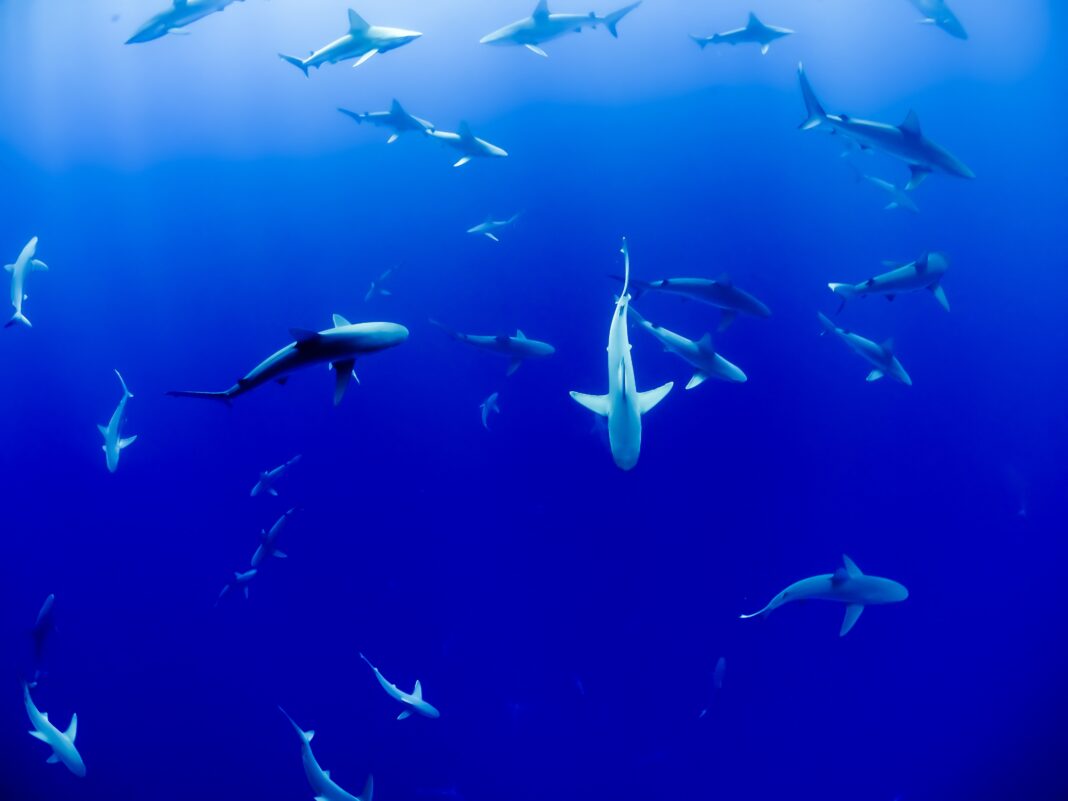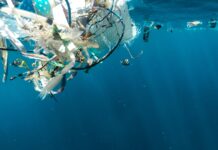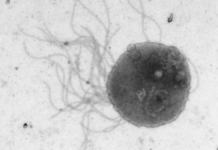Pneumonia, caused by Staphylococcus bacteria, is an infection of the lungs that kills 49,000 people a year in the United States1. Cholera, an intestinal infection caused by the Vibrio bacteria, kills 95,000 people a year worldwide. “Flesh-eating disease” (necrotizing fasciitis), caused by the same group of Streptococcus bacteria that cause strep throat, kills one person out of three infected. Although you may not recognize their names, you probably know the diseases caused by these deadly microorganisms. Yet, sharks and many other marine species do not mind their company.
For example, Streptococcus and Staphylococcus bacteria can be found in a shark’s mouth. After swabbing the teeth and gums of bull and tiger sharks in Recife, Brazil2, researchers identified numerous bacterial species that are pathogenic to humans and lead to infection in shark bite victims – but these bacteria appear not to harm the sharks. The function of this microbiome, the collection of bacteria, fungi, and viruses living on and in an individual, remains largely unknown but is thought to be essential for the health of the animals by helping to break down food and protect the organism against disease.
The Microbiome Helps Sharks Digest Their Food
Along with Streptococcus and Staphylococcus bacteria living in the mouth of sharks, the Vibrio bacteria can make up more than half of the bacteria living on the teeth of sandbar sharks3. But, instead of causing disease, some Vibrio species produce chemicals that may help these sharks break down dietary components such as starches4, protein4, and chitins5, which are chemicals that give shrimp, lobsters, and insects their hard exterior.
In addition to the mouth, microbes are also found within the gut of sharks, where they help to digest food6. Within species, research suggests that the diet of the shark plays a significant role in the composition of the gut microbiome 6,7, which stresses the link between food and the microorganisms that help digest it. Interestingly, Vibrio bacteria also seem to be an important part of the shark gut microbiome in at least three different shark species: spinner sharks, sharpnose sharks, and sandbar sharks6.
The Microbiome Protects Sharks Against Disease
Although Streptococcus is found in the mouth of the shark and rarely causes an issue, in February 2020, Morick and colleagues showed the first documented case of Streptococcus infection in a sandbar shark8. A post-mortem examination of the shark, found offshore in Israel, revealed the Streptococcus infection had gone multisystemic, affecting the heart and genital system.
Deadly Streptococcus infections have been reported in other wild fish species, including the wild mullet in Kuwait, where an outbreak plagued fish for two months in 2001. The bacteria were found in all organs sampled, including the brain, intestine, and eyes. Experimental inoculation of mullet with the Streptococcus strain found in the brain resulted in 100% mortality within 7 days9.
But, despite living in a hostile environment rich with infectious microorganisms10, sharks do not seem as susceptible to infections as other aquatic organisms. In fact, the Streptococcus infection of the sandbar shark was a rather unique find, as these animals rarely exhibit infection at all.
This reduced risk of disease in sharks may have evolved in the shark’s microbiome. Sharks and bony fish have both been found to contain Psychrobacters bacteria on their skin11, a bacterium reported to inhibit aquatic fungal pathogens12. Moreover, the skin microbiome may protect the shark when the skin is broken.
The Microbiome Protects Sharks Against Wound Infection
Pogoreutz and team11 found that the bacterial community in the gill areas of both healthy and visibly wounded sharks do not differ. This furthers the hypothesis that despite visible injury, the microbiome prevents pathogenic organisms from invading.
Not only do these microbiomes potentially help protect the shark against disease, but they may also help defend the shark against infection and could increase healing times. Sharks are well known for their fast wound-healing13, surviving wounds that would require medical intervention and months to years to heal in humans.
Chin and colleagues13 indicated that sharks can heal expeditiously from both major and minor wounds. Researchers observed various sharks with wounds ranging from 10cm to 20cm long and documented complete healing in as little as 40 days. As one example, a male blacktip reef shark was observed with a 10cm vertical cut splitting the first dorsal fin. The two parts of the fin merged back together within 44 days and, after 237 days, there was no visible wound or scar (Figure 1).
Imagine a 20-centimeter gash on your head, or a body part cut in two. Would you be able to heal without stitches and antibiotics?

The Microbiome and Humans
Sharks are not the only animals living harmoniously with microorganisms. Humans have a well-documented microbiome of bacteria, fungi, and viruses that are essential to our well-being. We have symbiotic microbes that live on our skin and in our bodies that are influenced by what we eat14 and where we live15. Our microbiome aids digestion16 and impacts our behavior17. These microorganisms, and many more, play a vital role in protecting us from infection18, in addition to affecting chronic diseases such as celiac disease19.
However, as we know, some microorganisms also cause disease in humans but live peacefully with other organisms. A better understanding of sharks’ tolerance to many human pathogens may supply new tools for use in human medicine.
Article by Cheyanne Poe and Christopher Stieha
References:
[1]“General Information.” Centers for Disease Control and Prevention, 11 May 2018, www.cdc.gov/cholera/general/index.html. Retrieved June 10, 2020.
[2] Interaminense, J. A., Nascimento, D. C. O., Ventura, R. F.,… and Lima-Filho, J. V. 2010. Recovery and screening for antibiotic susceptibility of potential bacterial pathogens from the oral cavity of shark species involved in attacks on humans in Recife, Brazil. Journal of Medical Microbiology. 59(8): 941–947.
[3] Karns, RC. 2017. Microbial community richness distinguishes shark species microbiomes in south Florida. Master’s Thesis, Nova Southeastern University, Florida.
[4] Gatesoupe, F., Infante, JZ., Cahu, C., and Quazuguel, P. 1997. Early weaning of seabass larvae, Dicentrarchus labrax: the effect on microbiota, with particular attention to iron supply and exoenzymes. Aquaculture. 58: 117-127.
[5] Sugita, H., Ito, Y. 2006. Identification of intestinal bacteria from Japanese flounder (Paralichthys olivaceus) and their ability to digest chitin. Letters in Applied Microbiology. 43: 336-342.
[6]Givens, CE., Ransom, B., Bano, N., and Hollibaugh, JT. 2015. Comparison of the gut microbiomes of 12 bony fish and 3 shark species. Marine Ecology Progress Series. 5518: 209-223.
[7] Egerton, S., Culloty, S., Whooley, J., Stanton, C., and Ross, RP. 2018. The gut microbiota of marine fish. Frontiers in Microbiology. 9: 1-17.
[8] Morick, D., Davidovich, N., Bigal, E.,…and Scheinin, A. 2020. Fatal infection in a wild sandbar shark (Carcharhinus plumbeus), caused by Streptococcus agalactiae, type Ia-ST7. Animals. 10.
[9] Evans, JJ., Klesius, PH., Gilbert, CA.,… and Al Zenki, S. 2002. Characterization of b-haemolytic group b Streptococcus agalactiae in cultured seabream, Sparus auratus L., and wild mullet, Liza klunzingeri (Day), in Kuwait. Journal of Fish Diseases. 25: 505-513.
[10] Moran, MA. 2015. The global ocean microbiome. Microbiome. 350(6266).
[11] Pogoreutz, C., Gore, MA., Perna, G.,… and Voolstra CR. 2019. Similar bacterial communities on healthy and injured skin of black tip reef sharks. Animal Microbiome. 1:9.
[12] Lowry, L., Woodhams, DC., Tacchi, L., and Salinas, I. (2015). Topographical mapping of the rainbow trout (Oncorhynchus mykiss) microbiome reveals a diverse bacterial community with antifungal properties in the skin. Applied and Environmental Microbiology. 81: 6915-6925.
[13] Chin, A., Mourier, J., and Rummer, JL. 2015. Blacktip reef sharks (Carcharhinus melanopterus) show high capacity for wound healing and recovery following injury. Conservation Physiology. 3(1).
[14] David, LA., Maurice, CF., Carmody, RN.,… and Turnbaugh, PJ. 2014. Diet rapidly and reproducibly alters the human gut microbiome. Nature. 505(7484): 559-563.
[15] Goodrich, JK., Davenport, ER., Clark, AG., and Ley, RE. 2017. The relationship between the human genome and microbiome comes into view. Annual Review of Genetics. 51: 413-433.
[16] Cantarel, BL., Lombard, V., and Henrissat, B. 2012. Complex carbohydrate utilization by the healthy human microbiome. PLoS ONE. 7(6).
[17] Johnson, KV-A. 2020. Gut microbiome composition and diversity are related to human personality traits. Human Microbiome Journal. 15.
[18] Belkaid, Y., and Hand, T. 2014. Role of the microbiota in immunity and inflammation. Cell. 157(1): 121-141.
[19] Olivares, M., Walker, AW., Capilla, A.,… and Sanz, Y. 2018. Gut microbiota trajectory in early life may predict development of celiac disease. Microbiome. 6(36)





